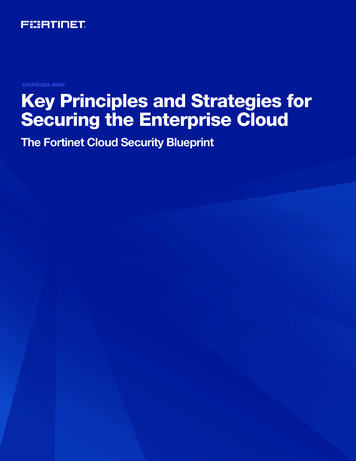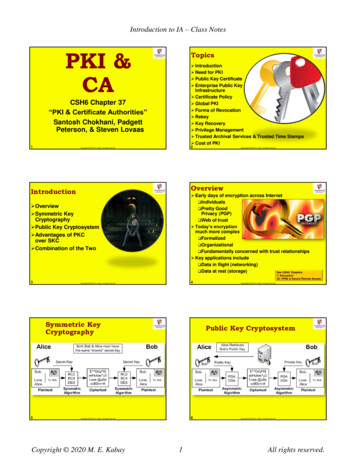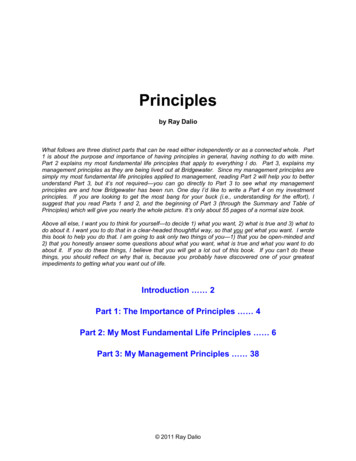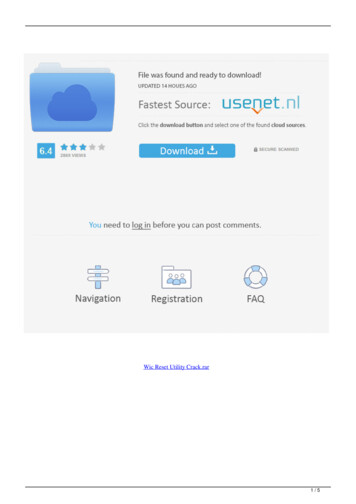
Transcription
STRATEGIES BRIEFKey Principles and Strategies forSecuring the Enterprise CloudThe Fortinet Cloud Security Blueprint
Executive SummaryCustomers are turning to the cloud to reduce capital expenses and increase agilityas part of their digital innovation (DI) initiatives. Despite the benefits, cloud migrationresults in business-critical data and services being scattered across clouds and datacenters. This leads to an expanded attack surface and a corresponding increase insecurity risk.Some organizations are unknowingly stumbling into a new security paradigm—theshared responsibility model, a model that is built on the assumption that the cloudinfrastructure will be secured by cloud providers, while security for services used inthe cloud are the responsibility of the organization.Enterprises use an averageof 61 different cloudapplications.1The Fortinet Security Fabric was purpose-built to close these cloud-driven securitygaps through native integration with public cloud infrastructures, a broad set ofsecurity services and products, and cross-cloud security management, automation,and analytics.IntroductionFortinet understands that DI is fueling unprecedented growth in cloud adoption. The heterogeneity of the resulting cloud environmentsexpands the overall attack surface. This, in turn, makes it increasingly difficult to protect applications. While public trust in the cloud hasincreased dramatically over the past decade, security remains one of the top concerns of business and technology leaders. It is critical thatsecurity is an integral part of the design process not just for individual cloud solutions but also for the broader, strategic move to dynamicmulti-cloud infrastructures.A Complex Array of Security ApproachesCloud providers go to extensive lengths to protect their infrastructure and isolate tenants. Yet, cloud providers vary in their approachesto implementing and managing their native cloud security capabilities. Often, different cloud providers implement the same securityfunctionality, but leverage different tools and approaches.For example, Amazon Web Services (AWS) extends security policies based on security groups that are associated with cloud resources.The Google Cloud Platform (GCP) uses firewall rules that offer equivalent functionality to AWS but are managed through different interfaces.Many of these differences stem from the unique way that each cloud’s underlying architecture is structured and the differing philosophiesthey have regarding cloud operations.For customers operating in multiple clouds, the default state of security is a heterogeneous architecture with no central visibility or control,and no consistency in how security is enforced and managed. In this context, each public and private cloud—as well as the on-premisesdata centers—become independent silos in a fragmented security infrastructure.The Cloud Shared Responsibility ModelThe shared security responsibility model defines the roles of cloud providers and customers in securing cloud-based applications anddata. According to the model, cloud providers are responsible for securing the infrastructure and tenant isolation, while the customer isresponsible for securing any resources and services used in the cloud environment. The cloud provider is also responsible for protecting theunderlying infrastructure from exploitation, intrusion, and abuse, and must also provide isolation between different customers.There are different versions of the shared responsibility model based on the type of deployment the customer has. Depending on the type ofcloud service offered, the responsibility split between the customer and provider will vary.2
STRATEGIES BRIEF Key Principles and Strategies for Securing the Enterprise CloudIn Software-as-a-Service (SaaS) deployments, the customer is limited to a basic set of security controls. For example, it is Microsoft’sresponsibility to secure Office 365, ensure the application cannot be compromised, and that customers can safely access the application.Customers, on the other hand, are responsible for platform configuration, tracking security events, and data.Public cloud-based deployments, such as Infrastructure-as-a-Service (IaaS) or Platform-as-a-Service (PaaS), require the customer to bemore deeply involved in security as they lay out larger infrastructures that need to be securely configured and managed. While public cloudproviders do offer some security tools, it is incumbent on the customer to select, configure, and manage the security solutions that meettheir needs. In this case, the customer is responsible for platform control and configuration, visibility into security events, access control,data encryption, and application security potentially through a web application firewall (WAF). The customer is also responsible for all onpremises portions of hybrid applications.Customers can turn to a designated security vendor such as Fortinet to provide the broad security they need to protect everything theybuild, deploy, or store in the cloud.Figure 1: The shared responsibility model shows the customer and the cloud provider are responsible for securing different resources.The Elements of Comprehensive SecurityToday’s evolving threat landscape requires a consistent and unified approach to cloud security. Fortinet follows three overarching principleswhen designing an effective multi-cloud security solution:1. Native Integration2. Broad Protection3. Management and AutomationAn effective cloud security solutionmust be developed while consideringthese three elements in order tosecure dynamic cloud enterprises.As demonstrated below, Fortinetcloud security solutions have beendesigned specifically in accordancewith these principles.Figure 2: The Fortinet approach to multi-cloud security.3
STRATEGIES BRIEF Key Principles and Strategies for Securing the Enterprise Cloud1. Native IntegrationFortinet distinguishes itself from other cloud security solution providers through broad, native integration with public cloud platforms.Native integration helps solutions interact with cloud-based information classification as part of the overall security policy management andenforcement capabilities. It is also able to leverage native cloud services for automation, threat monitoring, and tracking. Following are someof the key capabilities of the Fortinet natively integrated cloud security solution:Fabric Connectors. Fortinet security solutions programmatically integrate into the underlying cloud platform to provide maximum securitywithout operational overhead.Since cloud resources typically use metadata and labels to indicate their logical function or classify information, and IP address informationcannot be relied upon to make security decisions, Fabric Connectors can be used to normalize the use of different types of resourcemetadata across multiple clouds. They help to build and enforce consistent security policies across regions and clouds.More advanced Fabric Connector implementations learn and list the overall set of cloud resources and represent them in the form of anetwork topology. This makes it easier for security teams to investigate cloud security posture and to implement effective security policies.Optimization. While some vendors simply port their hardware operating system to a virtual instance, Fortinet solutions are designed fromthe ground up for cloud deployment. Fortinet solutions fit the needs of a broad set of resource and performance requirements. Solutionsrange from low-footprint images that maximize the benefits of scale-out architectures, allowing teams to deploy small footprint solutionswhere needed, to large-footprint solutions that leverage high-capacity networking drivers on different cloud platforms such as AzureAccelerated Networking, Oracle native mode, and AWS C5n instances.Automation. Fortinet makes it easy to automate common tasks, such as responding to different types of threats, by offering automationstitches, automation templates, and robust support for programmatic management via RESTful application programming interfaces (APIs).Automation stitches allow organizations to automate common actions through the GUI without any programming experience or deep clouddomain expertise. Fortinet provides extensive documentation of available APIs for those requiring more flexible and powerful automationcapabilities.High availability (HA). Fortinet solutions are designed to be deployed in various HA modes. Each cloud supports HA by leveragingdifferent capabilities. The underlying security must support each cloud environment in a way that offers consistent and predictable securityenforcement. In this case, it must support different active/active or active/passive schemes, natively integrating with each cloud to supportthe availability of business-critical systems.Auto scaling. One of the primary benefits of a cloud infrastructure is its elasticity and on-demand capabilities. This includes the ability toscale services in and out based on varying business needs—paying only for what is used. Fortinet support for native integration with theauto-scaling capabilities of the cloud enables the security infrastructure to keep up with cloud infrastructure scaling based on volume anddemand, ensuring that applications are continuously protected.Configuration templates. Templates can both reduce errors and help automate key processes such as auto-scaling cloud deployments.Fortinet configuration templates support a variety of frameworks, such as AWS CloudFormation Templates (CFT), Azure Resource Manager(ARM), HashiCorp Terraform, and Ansible, to help security administrators provision solutions quickly and accurately across various cloudplatforms and to meet the needs of cloud workload deployments. Configuration templates help to reduce the potential for human errorwhile accelerating the ability to attach security to new workloads and, in turn, ensuring that security administrators confidently deploy newworkloads.Service integration. Cloud platforms offer software and platform services that simplify the consumption of various capabilities byeliminating the need for users to master each technology. It is critical that security solutions integrate with each cloud platform and offersecurity functionality as part of the native service consumption model. Here, integration extends security protection to more use cases andservices as a fundamental capability, offering basic protection for experimentation environments as well as those that are not yet part of abroader security management life-cycle routine.4
STRATEGIES BRIEF Key Principles and Strategies for Securing the Enterprise CloudFigure 3: Three pillars of multi-cloud security.2. Broad ProtectionFortinet offers the broadest and most complete security portfolio in the industry, providing enterprise-class network and application security,as well as secure access products that share intelligence and work together to form a cooperative fabric. The Fortinet Security Fabriccombines an intuitive operating system, multiple layers of threat detection, and applied threat intelligence to deliver security, visibility, andcontrol.Security teams can reduce and manage the attack surface through integrated visibility, prevent threats through integrated artificialintelligence (AI)-driven breach prevention, and reduce complexity through automated operations and orchestration. Learn more about howFortinet delivers broad protection for the cloud:Zero-day threat protection. New zero-day, previously unknown threats are found nearly every day, and impact both cloud and onpremises deployments. As attackers increasingly employ AI and machine learning (ML) technology, the number of zero-day threats is likelyto grow.Fortinet provides a number of technologies for identifying and stopping zero-day threats, including sandbox analysis that observes potentialmalware in a simulated environment. The sandbox then determines if it can execute safely and be examined with behavioral tools formalicious intent.However, sandbox analysis is time- and processor-intensive, and can slow performance to a crawl if most traffic is not prefiltered. Fortinetemploys AI and ML for threat detection through analysis of characteristics, catching many threats before they need to be subjected tosandboxing. The ability to deploy sandboxing technologies, either in an IaaS-VM or as a SaaS application, is a critical capability that shouldbe part of any multi-cloud security strategy.SSL and IPsec VPN. Extending secure connectivity into and across clouds is critical. As traffic flows across the internet and cloudenvironments, the ability to isolate traffic and build consistent networking security policies are key enablers to unifying disparate cloudenvironments. The support of both site-to-site IP security (IPsec) VPNs and VPNs across virtual cloud networks is essential to consistentlysecure and isolate traffic. VPN implementations should be interoperable with different cloud VPN solutions, offering flexibility for differentorganizations and organizational units. Furthermore, the ability to deliver high-speed VPN connectivity is key. FortiGate VM is optimized todeliver secure, high-throughput connectivity without slowing cloud-based applications.Application control. Application control from FortiGuard services enforces security for internet-based applications and enablesorganizations to quickly create policies to allow, deny, or restrict access to applications. This service offers visibility and control of thousandsof applications and allows organizations to add custom applications. Teams can fine-tune security policies based on application type andoptimize bandwidth with application-driven traffic management.Secure SD-WAN. Fortinet has redefined the SD-WAN market by including its best-of-breed next-generation firewall (NGFW), SD-WAN,advanced routing, and WAN optimization capabilities, delivering a security-driven networking WAN edge transformation in the unified FortiGateoffering. A secure cloud connection is also critical to support seamless security operations. Fortinet received an NSS Labs “Recommended”rating in the SD-WAN group test and delivered the lowest total cost of ownership (TCO) per Mbps among all eight vendors.25
STRATEGIES BRIEF Key Principles and Strategies for Securing the Enterprise CloudZero trust. Networks designed with implicit trust simplify the ability for data and applications to move around inside the perimeter. Thiscontributes to network breaches that can remain undetected, allowing malicious insiders to steal critical data. The FortiGate VM NGFWsupports dynamic segmentation that utilizes logical attributes of data and applications across multiple locations and the cloud to provideconsistent isolation of resources with zero assumptions, validating every connection regardless of VLAN or origin network.NGFW. With organizations building more business-critical applications in the cloud, there is a greater need for advanced securitycapabilities. FortiGate virtual appliances for both ingress and egress security offer the same breadth of security functionality for the cloudas they do on-premises. Additionally, these solutions deeply integrate with various cloud platforms and are optimized to deliver highperformance in cloud infrastructures.Web application firewall (WAF). As DI fuels transition to business-critical applications, new applications are increasingly web-based.The FortiWeb WAF delivers threat protection for critical web applications and APIs. FortiWeb offers ML-based threat prevention andbot mitigation capabilities that fine-tune web security policies and eliminate false positives. FortiWeb helps organizations address therequirements of risk management policies and regulatory requirements related to protecting end-user information and ensures businesscontinuity.Email security. Email remains a common vector for malware, particularly as organizations migrate email systems to the cloud and relyon them as backup systems. By the end of 2022, cloud business email accounts are expected to account for 87% of all business emailaccounts.3 Fortinet email security solutions deliver complete protection from email-borne threats in the cloud and on-premises, and areideally suited to support cloud migration.Figure 4: A comprehensive solution that works across different delivery models, deployment models, and service providers.3. Management and AutomationUnifying an organization’s security infrastructure not only eases management but also helps ensure that consistent security policiesare applied wherever applications run, data is stored, or infrastructure is built. In addition, it enables the automation of security lifecycle management processes and helps ensure compliance. These capabilities allow organizations to manage cloud and on-premisesinfrastructures similarly by leveraging the same level of visibility and control. Centralized management and automation help organizationsmeet risk management and regulatory compliance objectives.Effective security management and automation consists of four primary elements: visibility, control, policy, and compliance. Fortinet enablesthese elements with its suite of management products including FortiManager, FortiAnalyzer, FortiCASB, and FortiCWP cloud workloadprotection (CWP).Visibility. The ability to consistently see all applications, networks, infrastructures, security events, and logs in a multi-cloud environmentis a cornerstone of a security posture assessment. Such assessments are both a starting point and an ongoing process of securitymanagement. Organizations need to identify resources spread throughout the infrastructure, associate traffic flows, understand which6
STRATEGIES BRIEF Key Principles and Strategies for Securing the Enterprise Cloudapplications are being used, and identify what data traverses the network. FortiAnalyzer provides inline visibility across Fortinet systems fordeep analysis, and FortiCWP provides visibility into the entire public cloud stack, leveraging cloud-specific APIs.This information allows an organization to validate whether security policies are effective, and if additional security policies are needed.In a multi-cloud environment where applications communicate across the various infrastructures, the ability to centrally trace traffic flowsand understand the sequence of events across each cloud environment often offers more insight than what standard security tools reveal.In addition, the ability to tie security infrastructure insights with cloud infrastructure visibility into a single pane of glass further simplifiesoperations.Control. Once an organization has full security visibility, the next step is to apply controls to relevant functions. This involves applyingconfiguration changes and populating the security infrastructure with the relevant resource-related information pertaining to the multi-cloudsecurity posture. Security management tools should extend a consistent control framework across the broad set of security functions.Additionally, the control framework should extend to the native security functionality provided by each cloud platform. This allowsadministrators and operators to apply security changes throughout the infrastructure, regardless of the underlying technology. FortiManagerhelps administrators apply consistent policies across infrastructures.Policy. Leveraging the visibility and control capabilities of the Fortinet Security Fabric enables organizations to gain consistent securitymanagement and enforcement throughout the infrastructure. Since the overall application life cycle is what drives changes to theinfrastructure, the burden and time to interpret how changes to applications affect the infrastructure are significantly reduced. Instead,security staff can modify security settings in accordance with application life-cycle events to achieve more consistent security policies.FortiCWP helps identify policy misconfiguration and compliance violations. It uses threat intelligence and native integration to assessconfigurations, monitor activity in cloud accounts, monitor cloud network traffic, analyze and scan data, and provide compliance reports.FortiManager further aids in multi-cloud policy management by enabling organizations to manage all of their Fortinet devices from a singleconsole. It provides full visibility of the network, offering streamlined provisioning and automation tools.Security staff can leverage these capabilities to shift to a strategic security posture by rapidly implementing policies in a centralized platformthat allows for faster updates.Compliance. Maintaining a consistent security posture and automating security operations significantly increases an organization’s abilityto maintain regulatory compliance. In addition, centralized security management, automated workflows, and shared threat intelligencehelp organizations quickly react to emerging threats. They also can more effectively mitigate risk across their entire attack surface withoutrequiring overly challenging security operations. FortiCWP and FortiCASB meet the compliance needs of organizations by identifyingcompliance issues and providing reports on compliance status.Security and Threat ResearchThis blueprint documents the primary elements of implementing effective solutions for consistent hybrid-cloud security with nativeintegration, broad protection, and management and automation. However, technology alone is not sufficient. A world-class cloud securitysolution must include security intelligence-based services that are used as data sources for the products determining threats. Theseservices should be backed by security experts with the skills and resources to master the rapidly changing world of cybersecurity.FortiGuard Labs boasts one of the largest security research and analyst teams in the industry with experts around the world. Thesededicated experts are always on the lookout for breaking threats and new techniques—studying every critical area of the threat landscapeincluding malware, botnets, mobile, and zero-day vulnerabilities.Additionally, FortiGuard Labs maintains an integrated threat-intelligence ecosystem with more than 200 security intelligence partnershipsand collaborations. The combination of an industry-leading research and analyst team with an extensive security intelligence ecosystemallows Fortinet to provide the leading-edge detection and protection organizations need to prevent, detect, and address new threatsfrom the onset.7
STRATEGIES BRIEF Key Principles and Strategies for Securing the Enterprise CloudCloud Security Use CasesThere are a variety of cloud adoption initiatives and security use cases to consider whenapproaching a cloud security strategy. The appropriate use cases for different cloud initiativescan vary. Often organizations engage in one of three types of cloud adoption initiatives asfollows:nConsuming SaaS applicationsnBuilding cloud-native applicationsnMigrating or extending existing applications to the cloudAll three initiatives require different security solutions to maintain a strong security postureand operational model. While the shared responsibility model provides useful guidance, mostorganizations will need to extend their visibility and control throughout the cloud regardless ofthe type of cloud adoption initiative they are taking on.While the overarching goal of increasing cloud visibility, control, and protecting applicationsis paramount with all three initiatives, the use cases and specific products to meet each goalwill differ. The three solution families for cloud security offered by Fortinet are: (1) visibility andcontrol, (2) application security, and (3) secure connectivity. The following section explains thedifferent use cases associated with each solution.1. Visibility and ControlFortinet Cloud Security UseCases1. Visibility and ControlnSaaS visibility and controlnCloud infrastructure visibility andcontrolnCompliance in the cloudnCloud-based security managementand analytics2. Application SecuritynWeb application securitynLogical (intent-based) segmentationnContainer securitynSecure productivitynCloud workload protection3. Secure ConnectivitySaaS Visibility and ControlIT teams and line-of-business leaders alike have embraced SaaS as a flexible, scalable, costeffective way to deploy business-critical applications. The issue is that as the use of SaaSgrows, usage is often unregulated, and security is often treated as an afterthought. Effectivecloud security must monitor all SaaS activity and integrate with security solutions to enforceuniform security policies across both traditional and SaaS-based applications.nSecure hybrid cloudnCloud security services hubnSecure remote accessFortinet delivers centralized control of SaaSapplications so organizations can deploybest practices with regard to compliance andgovernance. It also helps organizations protectsensitive data in applications from advancedthreats and brings Shadow IT applicationsunder centralized control. Organizations alsogain consistent application-control policiesacross all of a company’s branch locations.Enhanced security also helps reduce latencyand provides the level of performance thatusers expect.FortiCASB provides centralized, detailedvisibility on all SaaS application usage. Thisenables organizations to implement uniformapplication-control and security policies,protect their sensitive data against advancedthreats, and support security compliance andgovernance.Figure 5: Public cloud security use cases.8
STRATEGIES BRIEF Key Principles and Strategies for Securing the Enterprise CloudCloud Infrastructure Visibility and ControlAs cloud use increases, so does the likelihood of misconfiguration.In addition, since public cloud usage is not always monitored, it canlead to unchecked vulnerabilities.FortiCWP leverages the public cloud management APIs tomonitor activity and configuration of multiple cloud resources. Itcontinuously evaluates configurations across regions and publiccloud types and provides consistent visibility. FortiCWP simplifiescompliance violation reporting and enhances compliance byproviding guidance on security best practices. It also offers threatand risk management tools that help trace misconfigurations totheir source. FortiCWP supports AWS, Google Cloud Infrastructure,and Microsoft Azure.Figure 6: FortiCWP uses public cloud-native APIs to monitor security activityand configuration across clouds.Compliance in the CloudAchieving compliance with PCI DSS, HIPAA, SOX, GDPR, andother regulatory mandates can be a time-consuming burden.Migration to the cloud or multiple clouds only increases thisburden. Fortinet cloud compliance solutions include:FortiCWP, which aggregates and organizes security informationfrom multiple cloud services and APIs into meaningful compliancereports and live compliance dashboards.FortiSIEM, which provides a broader view of compliance acrossmultiple clouds, the Fortinet Security Fabric, and third-partyproducts. It can create compliance reports at the push of abutton.FortiAnalyzer, which collects logs from Fortinet Security Fabricelements, and FortiManager enables changes to be audited,reviewed, approved, and implemented. Together, they closethe loop on compliance gap mitigation. All systems supportautomated processes to facilitate compliance policy managementFigure 7: Fortinet solutions for cloud compliance.9
STRATEGIES BRIEF Key Principles and Strategies for Securing the Enterprise Cloudand workflow, reducing risk when policies are changed.Cloud-based Security Management and AnalyticsUsing legacy management tools alongside newtechnologies creates complex incompatibilities, especiallywhen seeking to manage from the cloud.To solve these challenges, organizations can leveragethe multi-regional and global presence of top cloudinfrastructure providers to deploy centralized and globalsecurity management and analytics systems in the cloud.FortiManager VM, FortiAnalyzer VM, and FortiSIEM VMcan all be deployed in the cloud to scale and globalize.Benefits include:nCentralized, unified security management and visibilitynEnhanced audit and compliance reportingnFaster incident responseFigure 8: Fortinet solutions for cloud-based security management and analytics.nImproved operational and cost efficiency, reducing risknIncreased ability to automate security management2. Application SecurityWeb Application SecurityCloud-based applications often use web services tocommunicate internally as well as outwards, leavingapplications vulnerable to various threats. Additionally,the organizations operating these applicationsare often burdened with meeting compliancerequirements.Fortinet offers a variety of web application securitysolutions that are ideally suited for cloud-basedcustomers. FortiWeb VM, an industry-leading WAFoffered on all major cloud platforms, secures web services APIs as well as front-end web applications from known and unknown threats.Figure 9: Fortinet protects applications against known and unknown threats.Through integration with FortiWeb, FortiGate VMscentrally enforce security policies and provide increased visibility. The Fortinet sandbox service performs dynamic analysis to identifypreviously unknown malware.10
STRATEGIES BRIEF Key Principles and Strategies for Securing the Enterprise CloudLogical (Intent-based) SegmentationSegmenting cloud environments is challengingbecause dynamic provisioning results in constantlychanging IP addresses. Network segmentationbased on static IP address rules is thereforeineffective.FortiGate VMs provide intent-based segmentation,which builds access rules and segments basedon user identity or business logic and adjusts rulesdynamically in response to a continuous trustassessment. FortiGate VMs leverage metadataor tags associated with cloud-based resourcesacross multiple clouds to enforce secu
security services and products, and cross-cloud security management, automation, and analytics. Enterprises use an average of 61 different cloud applications.1 Introduction Fortinet understands that DI is fueling unprecedented growth in cloud adoption. The heterogen











